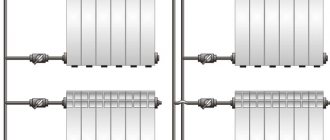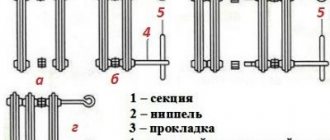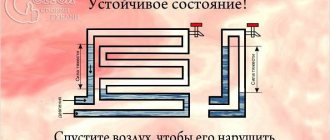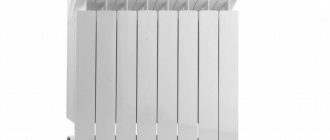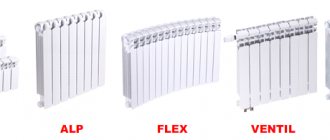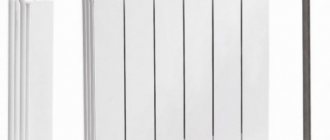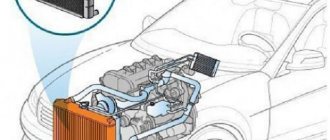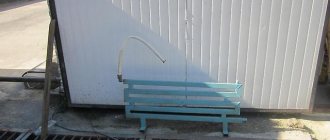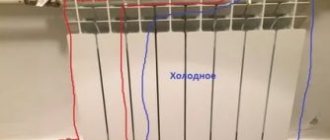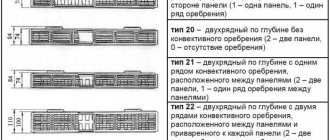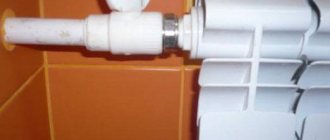Tools you will need to get the job done
First of all, to work, you should find out the exact dimensions of aluminum radiators. To measure them you will need a construction tape or a special folding meter. Also, if both types of instruments are not available, you can use a standard student ruler. It should be noted that most rulers are only 30 centimeters long, so you will have to make marks on the radiator (it is better to use a pencil, which is easily washed off the surface).
Each new mark will be the end of the previous measurement and the beginning of a new one. The resulting dimensions are added to form the true size. Disassembling aluminum radiators also requires other tools that it is advisable to use for dismantling work, namely:
- A complete set of wrenches (socket and ring).
- Radiator key.
- Pliers.
- Screwdriver.
Step-by-step description of dismantling work
A few words about when it may be necessary to disassemble a heating battery:
- In case of replacing an old radiator with a new one that has greater performance and better appearance.
- If necessary, add additional sections for the battery.
- If it is necessary to replace a separate section or gasket that has leaked.
The instructions begin with preparing the necessary tools:
Step #1: preparing tools
Photo of nipple wrench
Gas key sample
Advice: a nipple wrench, taking into account the fact that it is very rarely needed on the farm, and its price is not the lowest, it is recommended not to buy, but to rent. This will save the family budget.
Step #2: Disconnecting the Battery
Before disassembling an aluminum or cast iron radiator, you must disconnect it from the heating system. To do this, it is imperative to turn off the heating and drain the water from the riser, otherwise you will simply flood the room and get burns.
Advice: before starting dismantling, it is recommended to cover the floor under the radiator with film, rags, or at least newspapers to avoid contact with residual liquid that may end up in the circuit even after draining the riser.
Further, depending on the complexity, three situations can be distinguished:
- Polypropylene pipes. In this case, the coupling connection, as a rule, is twisted with bare hands, without causing any difficulties.
- Steel new. With some effort, you will most likely be able to untwist the inlet and outlet cords of the battery using a gas wrench.
Disconnecting new steel pipes
- Old steel or cast iron pipes. First we try, removing the paint from the joint with a blowtorch and a metal brush, we try to unscrew the connection as described in the previous version. But in systems that have worked for a long time, this most often does not give results, and then we simply cut off the runoff with a grinder or an autogen.
Cutting old squeegees using a grinder
After disconnecting the battery from the pipes, remove it from the hooks and lay it on a flat surface.
Step #3: disassembling the radiator
Battery sections disconnection diagram
A piece of pipe or crowbar
The battery can be cast iron, aluminum or bimetallic.
The most difficult option to analyze is the first one listed, so let’s start with it:
- How to disassemble a cast iron heating radiator on your own:
Carefully, check the thread progress on the futurkas or plugs, which can be either left or right. We insert the nipple wrench inside and increase its torque using a piece of pipe or a crowbar. We tear off the thread by turning the tool a quarter turn, first at the top and then at the bottom. Then we also alternately continue to unscrew the nipples so that the radiator does not warp. The main problem with old batteries is that the seals can become stuck during many years of use and cannot be turned on. In this case, the connection point must be heated in a circular motion with a blowtorch, and then try to unscrew the nipple again
We repeat the procedure until the thread gives way. If it still doesn’t work out, then you’ll have to cut it with an autogenous gun.
Disassembled old cast iron heating radiator
- Let's find out how to disassemble a bimetallic or aluminum radiator? The procedure is almost the same as described above, but has several differences:
- A smaller nipple wrench is used.
- So much effort is not required when unscrewing the nipples.
- Plugs and futuroks are marked with the thread direction in the form of the letters S and D, where the first indicates the left stroke, and the second - the right.
- The metal gaskets located between the sections are wiped, polished and stored until the subsequent assembly of the battery.
Disassembling an aluminum battery
After completing the described tasks, you can replace the leaking part, add a section, or even install a new radiator in place of the old one.
Design features of cast iron radiators
Cast iron radiators are similar in design, regardless of price. Most often they consist of one or more columnar sections with circular channels. The sections are connected to each other using nipples and are interspersed with sealing paronite gaskets (or gaskets made of heat-resistant rubber).
The number of sections is selected depending on the area of the room and the need for heat. Batteries can have a height of 350–1500 mm and a depth of 65–500 mm. Batteries are most often located under windows.
How to disassemble an aluminum heating radiator with your own hands
The aluminum battery is removed in the following cases:
- When the system changes completely.
- It is necessary to increase or remove the excess section.
- Fix the leak.
Before disassembling the aluminum heating radiator, you need to prepare a set of wrenches and a screwdriver.
Further actions are performed in the following sequence:
The coolant is discharged from the system. If disassembly occurs during the heating season, you should wait until the battery cools down.
Using a wrench, unscrew the coupling that connects the hose going from the battery to the heating pipe.
The disconnected radiator must be freed from any remaining water and placed on a flat surface with its face up.
The filter is removed from the battery and thoroughly washed. This must be done immediately, since the dirt accumulated in it can harden and then it will be extremely difficult to remove it.
Further work is to disassemble the battery into sections. They are connected to each other with special nipple nuts. To remove them, you need a key for disassembling aluminum radiators; by turning it counterclockwise, they can be easily removed from the radiator
This must be done extremely carefully to avoid distortion.
After disassembly, the battery cells are washed and assembled in the same sequence of actions.
If it is necessary to eliminate a leak, then for aluminum radiators a special solution made of epoxy resin with the addition of bronze powder is suitable. You need to work with this composition quickly, as it dries in a matter of minutes, so the leak site must be cleaned and prepared in advance.
Assembling a cast iron radiator
This is done in the reverse order, the only difference being the change in the direction of rotation of the key. Do not forget about replacing gaskets; it is best to buy paronite gaskets in the store, they are stronger, more durable and can withstand aggressive coolants (antifreeze).
If you don’t find such gaskets, you can use plumbing flax. It is wound onto the right-hand thread clockwise, and onto the left-hand thread in the opposite direction - counterclockwise. Also, for reliability, you can apply a sealant (for example Unilock) to the threads of the nipple nut. If you plan to use antifreeze in the system, then you cannot apply paint to the winding - it will corrode very quickly and you will have to repack everything. And this is draining the system, flushing it, disassembling it, then assembling all the sections... a lot of work. So, under a system with antifreeze, use a chemical-resistant sealant and paronite gaskets.
Dismantling an old radiator
In general, the process of disassembling an old cast-iron heating radiator is carried out in exactly the same way as a new one. But the problem is that over time, all connections become covered with scale and practically solder to each other. As a result, it becomes simply impossible to get by with just a plumbing radial wrench.
In addition, an additional item appears in the work - washing. The old radiator, in any case, is clogged from the inside with all sorts of dirt. Therefore, if you have already decided to improve it. then you need to take care of cleaning the equipment, this will allow it to work much longer and better.
It is advisable to wash it outside, this way you will protect the bathtub from damage. The procedure is carried out using ordinary running water, there is nothing complicated about it. But the further process can be very puzzling. If you find that the nuts have become firmly attached to the radiator and do not want to be separated from it, then you can use three different methods to break this union:
- The stuck compound can be separated using heat. To do this, you will need either a blowtorch or a hair dryer. The first option is much more efficient, but the second can also give the desired result. Using this auxiliary equipment, warm up the perimeter of the joint you need, and then immediately try to remove the nut without waiting for it to cool down. If it doesn’t help right away, repeat the same procedure several more times, after each attempt trying to figure out the problem again. Please note that working with hot metal is very dangerous. do not forget to protect yourself with protective clothing - mittens and an apron - and special glasses;
- If the previous procedure did not help, then you will have to try to solve the problem using a more radical method - cutting. The tool for this you will need is a hacksaw or a Bulgarian saw. The grinder does an excellent job of sawing metal, but here again you should take into account the fragility of the cast iron battery - if you cut in the same place for too long, the material may simply crack, and you will have to throw out the entire radiator. To prevent this from happening, you should make cuts in stages, giving the battery a little rest after each use. But in general. If you have the opportunity to spend a significant amount of time and effort, then it is better to use a hacksaw for cutting. Of course, this is a much more tedious and lengthy process than in the case of an angle grinder. But there is no risk of damaging the radiator in places where it is not required at all;
- the third option is even more brutal. If heating does not help solve the problem, and cutting is impossible for some reason, then there is only one way out - simply break the required section. This is done using a sledgehammer. Naturally, you shouldn’t hit it as hard as you can, because in this case you will be left without a battery. You need to act carefully and slowly, starting from the middle of the section and gradually reaching the point of its connection with the neighboring one. As with a blowtorch, be sure to wear safety glasses—even if you break it carefully, there is a risk that some of the pieces will bounce off sharply.
Dear readers, now you know how to properly disassemble a cast-iron battery, even if it is three times older than you and fiercely wants to maintain its integrity. Assembly is carried out, in general, in exactly the same way, but in reverse order.
Even if the radiator is completely new, all connections must be thoroughly cleaned with sandpaper before assembly. And in the case of an old battery, this is generally a mandatory procedure. In addition, it is advisable to replace all gaskets. If you had rubber ones before, then replace them with more modern ones made of silicone or paronite. These materials are much less susceptible to deformation and have a very long service life.
As you already understand, the most important thing in the process of disassembling a cast iron radiator is accuracy. The fragility of the material requires an extremely leisurely approach
In addition, do not forget about safety, which, as we know, comes first. With the right approach to the process, your cast iron radiator will serve for a long time and with high quality. Good luck!
Dismantling cast iron radiators
To dismantle cast iron heating radiators, the following set of tools is required:
- Pipe wrench number 3 (needed to unscrew the locknut and fitting);
- Pipe cutter or grinder;
- Hacksaw for metal;
- Chisel;
- Hammer and sledgehammer;
- Brush.
It is best to dismantle cast iron radiators (and any other heating devices) in the summer, when the heating system is turned off. Before disassembling the cast iron heating radiator into sections, it is necessary to drain all the coolant from the heating circuit.
The first step is to unscrew the locknuts that are located on the connections to the radiators. Next, the flaps are turned away, and the radiator can be removed. If it is not possible to unscrew the locknuts, then the connections are simply cut off, after which the radiator can be easily removed from the supports.
Disassembling an aluminum and bimetallic radiator
Before disassembling the heating battery, prepare the necessary tools.
The main tool is a nipple wrench (can be rented at a specialized store for little money). It is a rod about 700 mm long. On one side, a key head with a size of 24x40 mm is welded to it, and on the other, a through hole is made. You can insert a metal rod into it. It will make it easier to turn the nut.
This is the main tool used when assembling/disassembling heating radiators
There are several notches on the surface of the key. The distance between them corresponds to the width of the radiator section. By inserting the key inside the battery and counting the number of notches, you can easily find the nipple for the desired section.
Before disassembling the heating battery, you need to be aware of the direction of rotation of the key. Place the radiator on a flat horizontal surface with the front side up. On the right there will be a right-hand thread, and on the left side there will be a left-hand thread. In order not to get confused, you can do it simpler: take the nut and tighten it alternately on the right and left, and then decide in which direction to turn the key
This is important because the threads can easily be stripped and then you need to buy two new sections. Imported manufacturers make the following designations for threads on the plugs and fittings on the front side of the section: D-right, S-left
The thread on the nipple nut can be right-handed or left-handed, so before disassembling the radiator, we determine which direction to turn
Let's say you need to unscrew one section on the right. To do this, insert the key with a “spatula” into the upper hole to the desired location, secure it in the groove of the nipple nut and forcefully turn the key counterclockwise and “rip it off” from its place. This is where you may need a rod inserted into the ring on the key: a decent amount of force is required.
We make two full turns and move the key to the lower part of the radiator. We repeat the operation, rotating the key in the same direction. Unscrew the nipple 2 turns here too. We take out the key again and repeat the procedure for the upper part. So, one by one, unscrew the section completely. This is done to ensure that there are no distortions.
Do-it-yourself battery disassembly
Before unscrewing the elements, it is necessary to determine the direction of the thread.
You can disassemble a cast iron heating radiator into sections as follows:
- It is necessary to find out in which direction the blind plugs are unscrewed, and mark the length of the nipple to be unscrewed on the key. To do this, the key is placed on the radiator, the edge is brought to the point where the bushing is located. A mark is made on the key with chalk in a circle until the tool is inserted into the radiator.
- It is important to understand in which direction you need to turn the key for cast iron radiators. The thread can be right or left. The direction of rotation is determined by the sleeve, which is screwed in on the same side as the key.
- If the thread is right-handed, the fitting should be screwed in clockwise, therefore, when unwinding, the direction of the key should be in the opposite direction. With left-handed threads the opposite is true.
- Battery promotion begins from the first section. You need to carefully “break” the threads on both nipples. In most cases, half a turn of the key is sufficient. Next, the radiators are untwisted in sections on each side so that the interval between them is 0.5 cm.
- When unwinding the heating device, it is important to maintain the specified gap between the sections; if you neglect this rule, the thread may jam. When you start to unscrew the radiator, it is recommended to put the key on the pipe, this will allow you to use less effort during disassembly.
All modern cast iron batteries are disassembled using this algorithm. As a rule, such radiators are additionally equipped with plugs with appropriate markings.
Product design
The aluminum radiator is a structure of separate sections connected to each other using nipple nuts. Essentially, this connecting element is a cylinder with an external thread on each side. The cylinder is empty inside. Radiator sections are screwed onto each nipple nut on both sides.
The connecting elements are located at both the top and bottom of the battery. Thus, each radiator section is attached to the adjacent one at four points. The nipple nut is made in such a way that it is completely invisible in the assembled product.
Inside each connecting element there are protrusions that serve for the installation procedure. A special tool clings to them, with the help of which the nut is unscrewed and tightened. In this case, you should take into account the direction of the thread - on some elements it is right-handed, on others it is left-handed.
To avoid playing the guessing game, just pay attention to the markings in the appropriate areas. If the letter D is indicated there, this means that the thread is right-handed
The letter S indicates left
It is very important not to mix it up, since trying to unscrew the nut in the opposite direction can lead to thread breakage and, consequently, damage to the element
Working with a new radiator
The easiest way to disassemble, of course, is equipment recently produced by the factory. The joints have not yet turned into a single whole; everything unwinds and twists perfectly. If this is your case, then you are incredibly lucky.
In order to disassemble the radiator, you will need an adjustable wrench, as well as a special radiator tool. There will be no problems with the first one, but the second one is a unique and homemade product, it is usually not available in stores.
To get a plumbing radial wrench, you need to contact some workshop of the appropriate type and ask to rent the tool. Or try your luck with one of your familiar plumbers.
So, you need to follow a few simple steps.
- The first step is to turn off and drain the water in the heating system. If you live in a private house, you can do this yourself. If in an apartment building, you will have to first submit an application to the management company. A specialist will come from there who can turn off the riser. It is worth noting that this procedure can only be carried out outside the heating season, since turning off the coolant supply will affect not only your apartment, but also those of your neighbors.
- After the riser is closed, disconnect the radiator from the pipes connected to it (you will need an adjustable wrench for this) and remove it from the fasteners with which it was held on the wall.
- Then you need to open a special plug on the side of the battery, tilt the radiator and drain the remaining water from it. Of course, this needs to be done over some container. Before taking on this work, remember the considerable weight of cast iron and invite an assistant.
- Using a plumber's radial wrench, unscrew the bushings that connect the radiator sections. This is not so easy to do. First try to determine the direction of the thread. However, with modern radiators this is not difficult to do, since the bushings usually have corresponding markings. If you need to disconnect one of the extreme sections, then simply feel it with a tool. If we are talking about the middle segment, then make a mark on the key showing the passage of the required distance. Then insert the tool into the battery to the desired level and begin unscrewing. This must be done with great care, slowly - remember that cast iron, despite its impressive appearance, is a rather fragile material. You need to work alternately with both nuts, upper and lower. First, unscrew one of them half a turn, then the second one, then return to the first one again, and so on. This will help avoid skewing the radiator.
- Once the nuts are completely unscrewed, the section can be removed.
Dismantling cast iron heating radiators
Disassembling cast iron radiators sometimes becomes a very labor-intensive process, but necessary.
Scheme for disassembling cast iron heating radiators: a - gripping thread sections with nipples for 2-3 threads; b - additional turning of nipples and joining of sections; c — connection of the third section; d - grouping of two radiators; 1 - section; 2 - nipple; 3 - gasket; 4 - short radiator key; 5 - crowbar; 6 - long radiator key.
The new or old radiator is placed on a level place. At least on one side you need to remove the usual footers or blind plugs. On different sections of radiators they can be with left-handed or right-handed threads. Typically, cast iron fittings have a right-hand thread, and plugs have a left-hand thread. If there are no disassembly skills and there is a free section, it is better to find out, before applying force, what type of thread this is and in which direction the key should be turned. If the thread is left-handed, when disassembling cast-iron batteries you need to turn the key clockwise.
As when unscrewing any nuts, you first need to “tear” the fittings out of place, i.e. Turn them a quarter turn on both sides of the battery. Then the footers are unscrewed so that a gap of several millimeters is formed between the sections. If you release the feet more, the entire structure will begin to bend under its own weight and due to the applied efforts. In this case, the thread may jam. To prevent this from happening, an assistant must stand on the battery being disassembled, who will prevent bending with his weight.
Usually, disassembling old heating radiators is difficult because the fittings and sections are “stuck.” In order to disassemble such a battery, you will have to use an autogen or a blowtorch. The junction is heated in a circular motion. As soon as it is warm enough, the futorki is unscrewed. If you fail to unscrew it the first time, the steps are repeated.
If you do not have enough strength to disassemble the battery, you need to increase the length of the key. An ordinary pipe is used, which serves as a handle.
The built-in nipples for venting cast iron radiators are unscrewed in the same way.
If it was not possible to disassemble a cast iron battery using the methods considered, all that remains is to cut it with a grinder or autogenous gun, or break it in a lying position with a sledgehammer. You need to carefully break or cut one section. After this operation, the adhesion between the sections may weaken, the battery can be disassembled, and the remaining sections can be saved.
The use of a “liquid key” or WD fluid has no effect, since in old cast-iron batteries the fittings were sealed with flax and paint, and liquids will not get on the threads.
How to disassemble a cast iron radiator
Immediately before the sector is unrolled, it is worth placing a metal rod on top of the radiator and aligning the working surface of the element with the mounting sleeve. From the end of the structure, make a point on the rod with chalk and place the assembly in the battery up to the mark. Thus measure the length of the pipe.
Alternating twisting of the nipples will prevent the threads from jamming
Next, you need to decide on the type of thread (right or left), since the direction of rotation of the pipe wrench depends on this. This is quite easy to find out; you need to unscrew the free bushing, after which the direction will appear. If the thread is right-handed, then you need to turn the tool counterclockwise. The left one is naturally in the opposite direction.
After disassembly, the threads and rotating elements must be cleaned of rust.
The next stage is the promotion of the radiator itself. To do this, you will need to disassemble the sectors, stripping the threads from the nipples one by one. The procedure should be performed carefully, keeping the width between sectors no more than 5 mm. Otherwise, the section may become skewed, resulting in the nipple jamming. A steel pipe acting as a force arm will help disassemble the structure.
How to disassemble an old cast iron battery
Typically, a blow torch or torch may be needed to disassemble a section of an old cast iron radiator. The problem is that over time the threads become corroded, making rotation almost impossible. In this situation, the joints should be heated, and then tear off the nipples on both sides of the radiator.
Timely cleaning of the battery will facilitate the disassembly process
If the battery has served for a long time, the nipple will most likely be completely rusted. Under such circumstances, a pipe wrench will be useless, so it is better to use a grinder or a metal saw. You can disassemble the excess parts of the nipples using a hammer, and clean the damaged areas of the radiator with a wire brush.
When none of the above options helps, then you should use a sledgehammer and break the excess parts of the radiator. Place the cast iron battery in a horizontal position on a wooden shield, and then hit the deformed sector. The impact location will be the middle axial surface of the section. During the procedure, the sectors will begin to fall off the structure.
How to disassemble a new cast iron battery
It is worth noting that in frequent cases, even new heating devices fail and there are many reasons for this: manufacturing defects or poor-quality assembly of components. In any case, you will have to resort to repairs, which means disassembling the cast iron battery.
You can remove the covers on new batteries using a regular adjustable wrench.
To disassemble a new battery, you first need to disconnect it from the power line, draining all the liquid. Water in the radiator will add weight to the structure, making it difficult for one person to remove the radiator. Next, you should carefully place the heating element on a tray or ladder in a horizontal position. On new batteries, the threads cannot be damaged, so twisting the sleeves and plugs is not difficult. The first ones need to be removed smoothly and sequentially one after another. The width between elements should not exceed 5 mm.
Important! When disassembling new batteries, it is not recommended to use a soldering iron or sledgehammer.
How to disassemble cast iron batteries with your own hands
Most often, houses and apartments with old layouts are equipped with MS-140 cast iron batteries. Nipple nuts and sealing gaskets are also used to assemble their sections. It is especially difficult to disassemble an old battery, because... Over the course of its long-term operation, the spaces between the sections began to boil with rust. As a rule, in such cases, the niches for keys are corroded by the coolant
It is also important to keep a significant mass of cast iron in mind. For example, the weight of one battery for 12 sections is 90 kg: it will be difficult to handle such a product alone
To implement the procedure, you will need the following tools:
- Nipple radiator key.
- Plumbing fixtures for unscrewing fittings and plugs.
- A small sledgehammer and chisel.
- Blowtorch (it can be replaced with a hair dryer).
- Steel brush.
- Wooden blocks for installing the battery on the floor.
A round metal rod with a diameter of 18-20 mm, flattened at one end, is used as a radiator key. The dimensions of the flattened part are 28x40 mm, with a thickness of 6 mm. A ring is welded to the opposite edge of the rod through which the lever is threaded. The length of the radiator key should be half the largest battery for 12 sections, plus 30 cm.
How to properly disassemble a cast iron battery into sections and reassemble it
- Working with a new radiator
- Dismantling an old radiator
From the author: Hello, dear readers! When the market was flooded with heating radiators made from various modern materials, cast iron radiators began to lose ground.
Which, in general, is not surprising, because they used to be made in the same design (if you can even call it that), and were bulky and ugly.
However, cast iron has not given up, and now more and more people are starting to purchase such radiators. By itself, this material has excellent characteristics, and modern technologies make it possible to obtain a beautiful and functional product.
For example, now these radiators can be expanded. But to do this, you need to know how to disassemble a cast-iron heating radiator into sections and then reassemble it.
However, this information will be useful to you not only if you want to strengthen the heating system, but also for repair procedures from which no radiator is immune. Fortunately, the disassembly process is not that complicated, and even an inexperienced home DIYer can handle it.
Disassembly procedure
It is very difficult to separate stuck intersection joints. In some cases, they become so attached that even significant physical efforts are powerless. In such situations, the joints are heated before disassembly using a blowtorch or hair dryer.
How to disassemble a heating radiator made of cast iron:
- The cast iron is heated with a blowtorch until it begins to emit a crimson glow. After this, you can begin the disassembly procedure.
- The first step is to unscrew the plugs.
- The radiator key is brought to the top of the battery: its head should be in the area where the nipple nut is unscrewed. At the end of the section, you need to use chalk to mark the circle for the location of the tool rod.
- The flattened part is inserted into the lower internal groove. Next, moving the tool in the desired direction, bring it to the marked circle.
Before starting the operation, it is important to find out in which direction the sections need to be twisted. If there is a nipple nut, screw it in turn onto the right and left ends of the battery: this makes it possible to determine the direction of rotation of the nipple
If the thread moves, it should not be completely unscrewed. To avoid distortions, the upper and lower nipples must be unscrewed one full turn alternately.
From the author:
Hello, dear friends! Often, home owners are faced with the question of how to disassemble an aluminum heating radiator. This happens in two cases. The first is a breakdown of the equipment, a malfunction, or a leak in one of the segments.
The second is when the power of the product is not enough to heat the room efficiently. This usually happens if the required indicator is initially incorrectly calculated. That is why it is recommended to invite a specialist to pre-calculate the required parameter.
A professional makes calculations taking into account even the slightest nuances. In this situation, all factors are important - for example, the climate zone in which you live, the area of the premises that need heating, the condition of the window frames, the presence of an insulating layer on the walls, and much more.
It is clear that a person who does not have the appropriate knowledge and experience will not be able to correctly calculate the required power. Therefore, in fact, it often turns out that an aluminum battery is simply not able to provide the required amount of heat. Fortunately, this problem can be solved quite easily by disassembling the product and adding the required number of sections. You will learn how to do this from today's article.
Calculation of the required heat transfer by room area
The heat transferred by the battery to the room air should compensate for its heat loss. In simplified form, this means that for every 10 square meters of room area, radiators with a thermal power of approximately 1 kW should be installed. Learn more about the methods for calculating heating batteries.
In reality, this figure is increased by an additional 15% or the resulting battery power is multiplied by another factor of 1.15
This is a very approximate method, which is used when the ceiling height in the room is not higher than 2.7 m. In addition, this method does not take into account the number of windows and type of double-glazed windows, the number of external walls and their thickness, and the climate zone.
Calculation of the number of sections of a cast iron radiator
The radiator power is usually expressed as the power of one section. Cast iron batteries are assembled from separate sections. Each section has a power of approximately 0.15 kW (or 150 W). The value may vary slightly depending on the section geometry.
The power of each individual section is directly proportional to its surface area. For any standard cast iron products, the area value is the same. The principles of calculation are comparable to the selection of low-voltage equipment and aluminum radiators.
An ordinary room with an area of about 15 sq.m. will require 10 cast iron sections. Each additional window is 1 or 2 additional sections. If the area of the premises is more than 20 square meters, it is better to install 2 batteries with a total power.
The standard power of the devices must be increased proportionally if the ceiling height exceeds 3 meters. For example, for a ceiling of 3.1 m, you need to calculate 3.1/3 * 120 = 124 W.
The main reasons for repairing an aluminum radiator
Why do such incidents happen? The fact is that aluminum heating batteries are not entirely suitable for installation and operation in such buildings, due to the limit of the permissible operating pressure of the product. For aluminum radiators, the maximum (permissible) operating pressure is within 15 atmospheres. Installing an aluminum radiator in an apartment, with an external heat source, forces the product to work to the limit, since the operating pressure of the central heating system, as a rule, is within 12-15 atmospheres, and during pressure testing (starting the system) it reaches much more.
As you understand, an aluminum battery failure under such operating conditions is inevitable and can happen at any time and it is not necessary that you will be at home and be the first to know about it. This means, based on the above, a sudden failure of an aluminum structure can entail large - serious financial expenses, which will have to be spent not only on repairing your premises - apartment, but also on compensation for the consequences of the accident for your neighbors .
But there are other reasons that force urgent repairs, interference with the integrity of the battery structure, that is, the involvement of a qualified specialist or disassembling and assembling an aluminum heating radiator with your own hands. If you decide to make do, for the sake of economy or other circumstances, on your own (on your own), then you will have to thoroughly study the topic and find out: “How to properly disassemble and assemble an aluminum heating radiator with your own hands?”
As practice shows, there are three main reasons that require urgent, professional repair actions (disassembling and assembling an aluminum heating radiator yourself):
- The heating battery is clogged. The radiator is barely warm (not all sections are the same temperature), although the pipe, the heat source, is hot. Such a defect requires disassembling and washing the product;
- Battery leakage between sections. Moisture appears between the connections of sections or liquid leaks - this requires disassembling the structure and replacing the sealing elements;
- The occurrence of a leak in the radiator section. The appearance of a crack or other defect directly in the section itself, which provokes leakage or leakage of the structure, requires replacement or restoration of the sectional element, or the entire battery.
Basic elements for radiator installation
In most cases, radiators are sold assembled; to operate, the device only needs to be fixed on the wall and connected to the heating system. However, in addition to this, you will need to purchase additional devices. These include the following:
- Pass-through plug for a cast iron radiator in an amount of at least 2 pieces. The device has holes on both sides in which threads are cut.
- Plugs that are screwed into the radiator body to prevent coolant leakage.
- Mayevsky taps for bleeding air from a heating device.
- Devices for installing radiators, these can be metal anchors or special brackets.
The number of radiator sections is determined by the need for thermal energy, so the length of the heating device is increased or shortened.
Modern specialized stores offer radiators and a full set of accessories for their installation. This allows you to select elements of the same color in accordance with the color of the heating device. In addition, in this case it is possible to select the most compatible materials. For example, if the battery is made of cast iron, then the plugs should also be cast iron. It is not recommended to use a plug for a cast iron radiator on copper heating appliances.
Useful tips
Interesting fact. Many people do not want to use cast iron radiators solely because of their appearance. But recently, retro cast iron heating batteries have become widespread. Precisely those models that were so diligently avoided. Fans of retro style often specially order such models in stores. Fans of a more modern design can be offered to decorate cast iron radiators with special screens.
There is no heat loss from the screens, but the batteries look somehow particularly simple, but stylish. For those who do not want to change their batteries, you can simply restore them to their original beautiful form. The batteries can be repainted using modern materials or you can give them a rather unusual look yourself. When choosing materials, be sure to choose those that can withstand high temperatures of more than 80 degrees. It is advisable to consult with sellers about painting materials. There are some paints that can change color when exposed to hot surfaces. In this case, by carefully painting the battery snow-white, you can see a completely non-crystal white version during the heating period.
How to disassemble a cast iron radiator with your own hands
Sooner or later, it may turn out that even a cast-iron battery will require a complete replacement or simply need to be cleaned. In both options, the battery will have to be disassembled. How to disassemble a cast iron heating radiator with your own hands quickly enough and as professionally as possible? The fact is that such radiators are the best option for use in apartment buildings. These heating elements are able to withstand all the vicissitudes of an imperfect heating system. Sometimes over time, even cast iron has to be replaced because it has leaked or simply does not fit into the new renovation of the apartment.
Although even today cast iron batteries are still relevant. Many users do not want to exchange such good heat sources for new, but such short-lived heat sources compared to cast iron. Therefore, most people try to put their batteries in order by simply repainting them. Some use decorative screens for cast iron batteries. Very comfortable and looks like new radiators and there are no problems in the design. (See also: DIY installation of heating radiators)
Any replacement of batteries can be performed only in the summer, when the heating season has not yet begun or, on the contrary, has just ended. But sometimes circumstances develop in such a way that you have to change and disassemble the battery in winter. For example, if the battery leaks, what should you do? Should we wait for summer or for the fact that one day the radiator will burst and the neighbors below will be flooded?
You can try using the services of plumbers, but you can handle the situation yourself. In order to disassemble a cast iron battery, you need special tools and some knowledge, which we will tell you about.
Design of heating radiators
A standard battery is assembled from individual cast sections, without the use of external fasteners or retainers. Thus, you can build a radiator of almost unlimited length.
To properly disassemble a cast iron battery, you need to know some features of its design:
- The individual sections are assembled into one housing using internal threaded bushings or nipples. To disassemble a cast iron radiator, you need to be able to remove the end plugs and internal inserts;
- Each nipple is a cylindrical glass, on which two sections are cut with threads of two types - with left and right directions of turns.
End caps are also manufactured with two types of threads; as a rule, blind plugs are produced with a left-hand thread, and the fitting nut for connecting to a pipe is produced with a right-hand thread.
Important! To disassemble the sections, you will need to choose the correct direction of rotation, otherwise you can quickly break the cast-iron battery case.
To secure a separate register into a common cast-iron body, a pair of nipples are used, which are simultaneously screwed between the two sections with a long key with a square head. In order to disassemble and avoid splitting the cast iron body, you will also need to carefully unscrew the nipples, making only 1-2 turns on each.
Battery assembly
In principle, with the necessary tools at hand, even a beginner can assemble or disassemble an aluminum radiator with his own hands.
To install an aluminum radiator heater with your own hands, you need to:
Place the battery on a flat surface. This is necessary in order to inspect the device before installing it and check all joints for possible cracks or chips.
Before connecting the heater elements, the threads at the joints are cleaned not only of debris, but also of factory paint. This is done using fine-grained sandpaper.
This is important, since in the future the paint layer may crack, which will lead to leakage. For the sake of presentation, manufacturers paint not only sections of radiators, but also their joints.
When cleaning the battery from paint, you need to make sure that the sandpaper does not leave scratches on it, which could also cause a leak in the future.
All gaskets should be washed in soapy water. and if antifreeze is supposed to be used in the heating system, then they need to be degreased, since this carrier is capable of penetrating into any, even the most minor, irregularities.
Before connecting the sections, it is advisable to study the drawing of the key for assembling an aluminum radiator so that you know how to use it. This metal is very soft, so any too much force can damage the threads and then you will have to buy a new section.
A paronite seal is placed on the nipple nut on both sides. The key is placed on top and easily turned a couple of times, the same is done with the bottom hole. Only after the joints have been tacked can you use a lever to tighten them more tightly.
The hole that will not be used is closed with a plug, and the Mayevsky tap is attached to the other and the assembly of the aluminum radiator is ready.
Once all sections of the radiator have been assembled, it can be connected to the heating system and checked for possible leaks. Since aluminum batteries are quite lightweight, you can easily connect them yourself, even without the appropriate skills.
How to solder an aluminum car radiator with your own hands
Let's move on to the soldering process. First, the problem area is thoroughly cleaned with a file and sandpaper. Before you start replacing the Peugeot 307 timing belt with your own hands, you need to prepare the tools that we will need for this operation on the nfu engine. If there are lamellas on it, they must be carefully removed with pliers. Aluminum radiator with your own hands, a car that, as already. Next, the repair area is degreased with acetone.
When preparation for soldering is completed, flux can be applied. After this, we begin to warm up the joint. If you use a gas torch or blowtorch, make sure that the flux does not burn out prematurely. It is easier to apply it with a soldering iron. It is enough to dip its working element in the mixture and transfer it to the surface to be treated.
Now it's time to apply the solder. How to repair a Toyota radiator It is better if it is in the form of a rod or wire. Solder is applied to the joint and thoroughly heated with a soldering iron (torch). When it spreads evenly, you need to let it cool, after which it is advisable to apply a second (safety) layer. At the end of the work, the resulting sagging can be removed using sandpaper.
Dismantling an old cast iron battery
If the connections are painted over, use a blowtorch to heat it up.
If you have to disassemble an old cast iron battery, some difficulties may arise. If the thread is stuck, before disassembling it you need to thoroughly warm it up using an autogen or a blowtorch. When the joints are sufficiently heated, you need to quickly tear off the nipples on both sides simultaneously. Using a similar principle, other stuck-on radiator elements are also unscrewed.
After prolonged use of the device, the metal may become thoroughly rusted. For drastic measures, you may need a grinder and/or a hacksaw. The remaining nipples must be unscrewed from their places and the threads are cleaned with a brush.
Sometimes the use of the described methods does not have the desired effect. The only solution to the problem in this case is to break the radiator with a sledgehammer. First, the battery is removed from the mount, placed on a flat horizontal surface and hit on the axial part of the section until it falls off.
Do-it-yourself disassembly and assembly of an aluminum radiator
The area where the radiator restoration will be carried out is covered with thick fabric
. If this is a table surface, then the main work will not take place in weight. The prepared area will protect the soft aluminum from receiving unnecessary deformations and scratches.
Important ! Before removing the union couplings, a rag is spread under the radiator to protect the floor from dirty liquid that may leak out during dismantling. You need to have a rag on hand to absorb any remaining moisture remaining inside the sections
Disconnection from the heating network
Before disassembly begins, the radiator is disconnected from the heating network using shut-off valves
.
If there are no shut-off valves at the radiator, then a housing and communal services worker is invited
to turn off the heating riser for repair work.
During the heating season, after shutting off the radiator, they take a break. Since the water in it is still hot, wait for a while until the liquid cools down
, and then disconnect the radiator from the heating pipes.
Coolant
, remaining in the battery,
is poured into a previously prepared bucket
and the sections begin to be separated. Immediately after dismantling, the inner surface of the battery is washed with running water.
How to disassemble and reassemble the battery
Aluminum sections connected by nipple nuts
.
The inner part of such a connector has protrusions by which the nipple wrench grabs the nut and unscrews it. A nut is similar to a coupling, only it has an external thread
. One nipple nut has both right-hand and left-hand threads. They are made in pairs for the top and bottom connections. When the nipple is untwisted, the sections move apart, and when twisted, they are pulled together.
All plugs and adapters are pre
. The connector must be accessible from all sides by the nipple wrench.
Photo 1. Fastening sections of an aluminum radiator to each other: the nipple nuts unscrew when disconnected.
To disassemble the battery, the tool blade is placed through the open end of the radiator into the grooves of the unscrewed top
nipple nuts and with some pressure make a test
rotation counterclockwise
to move the connection.
If the key turns the nut normally, then insert it into the grooves of the lower
nipple nut and, as in the first case, try to turn it a couple of turns.
Important ! When unscrewing connectors, follow the sequence of actions to avoid distortion. After disconnection, the exposed thread is carefully examined for cracks and chips, and for the integrity of the thread
If necessary, the joints are cleaned with fine emery cloth.
After disconnection, the exposed thread is carefully examined for cracks and chips.
, for
thread integrity
. If necessary, the joints are cleaned with fine emery cloth.
When assembling the radiator sections, paronite O-rings are placed on the upper and lower nipple nuts
, placed between sections.
I lightly press the sections together and screw them together alternately. Turning the nuts
to avoid distortion is limited to
two turns of the wrench
.
If something went wrong
During operation, the joints between sections and steel nuts stick to each other
. This comes from the quality of the coolant supplied to the heating system. Sometimes even significant physical efforts are useless.
Although sticking needs to be dealt with, aluminum is easily deformed
because it is a soft metal.
By heating the joints with a construction hairdryer, you can overcome stuck rust
. If this doesn’t help either, because the corrosive build-up is too corrosive, then the edger gets to work.
Advice.
If the nipple nut does not turn off under great pressure, then
there is no need to increase the applied force with excessive leverage
. In the worst case scenario, not only will the nut itself break, but both sections that sit tightly on the nut will crack.
The leaky section is trimmed with a grinder
, and on the reverse side and departing from the edge of the connection by no less than half the length of the coupling. This protects the working section from destruction and does not cut the connecting nut. During cutting, the rust bounces off, making it easier to unscrew the surviving section.
How to disassemble a new cast iron radiator
Cases when new plumbing equipment fails are not uncommon. The reasons for the failure are various. As a rule, this is either a factory defect or a non-professional assembly of the elements of the heating structure. There are other reasons that require you to remove and disassemble a new cast-iron heating radiator yourself. One of these is the need to increase or decrease, sometimes this happens, the number of battery sections.
New cast iron radiators
It doesn’t matter what problem prompted you to disassemble the heating plumbing fixture, but the sequence of repair actions is the same. First, the cast iron structure must be disconnected from the communications and removed from the hooks of the clamps.
Before carrying out such activities, it is necessary to completely drain the liquid from the heating system of a residential building. By the way, it is advisable to immediately drain the water from the heating radiator, a little, by lifting one of the sides. This way you will significantly reduce the weight of the structure and avoid many side incidents. Like, liquid getting on the floor, with the ensuing consequences.
Due to the heavy weight of the plumbing fixture, repair work is best carried out with an assistant. You must understand that during disassembly and assembly of a cast iron heating radiator, you will have to lift and tilt the structure more than once. Therefore, physical assistance will be very helpful. This approach will make the repair process much easier for you and make it less dangerous.
Next, we lay the removed cast iron radiator flat on a previously prepared platform, face up. This could be a wooden board or pallet. Then, using an adjustable wrench, unscrew the plugs and fittings. Futorki - hollow nuts, with internal and external threads, which are intended for connecting heating pipes to a heating product.
How to disconnect a section of a cast iron battery
Radiator key
Now, it’s time to find out how to properly disconnect the section of a cast iron heating radiator. To do this, we need a special plumbing tool - a radiator wrench. You won’t find similar plumbing equipment in a store, but you can make it yourself, rent it, from a specialized service center or from a familiar plumber. The tool is specific and individual, it is a homemade device. As a rule, it is not possible to encounter two identical radiator keys. Their only similarity is the rectangular tip, 40 by 24 mm. Typically, such a tip is welded to fittings or a pipe with a diameter of 15-20 mm and a length of 60-80 centimeters. On the other hand, they make a special eyelet so that it is possible to insert, for a lever, a pry bar or a long crank.
What needs to be determined before unwinding the structure
Before unscrewing the structure, it is necessary to determine the direction of the thread of the nipple nut. Typically, it corresponds to the thread direction of the plugs and fittings. But there are exceptions. So, you need to approach disassembling a cast iron heating radiator with full responsibility and not rush to immediately use physical force if something goes wrong. Also, on modern heating products, sometimes you can find markings that indicate exactly which thread is: L - left, R - right.
Nipple nut
Once you have decided on the thread direction of the nipple nut, you can confidently begin disassembling the cast iron battery. If you need to unscrew the outer sections, then determining the required connecting nut will not be difficult. With segments that are in the middle or even closer, it is not much more difficult, but still possible. To do this, we measure the distance to them by placing a radiator key on top of the structure. We mark, on the fittings or pipe of the key, with chalk or a marker, the place to which you need to insert the radiator key, inside the product, in order to unscrew the sections. Next, we insert the homemade tool to the previously noted distance, turning it slightly. Such translational rotations will allow the tool to pass other nipple nuts along the way and reach the desired hole.
How to disconnect a section of a cast iron battery
Having reached the desired nipple nut, fix the tip of the radiator wrench in it. Then, on the other side of the plumbing fixture, insert a long wrench or pry bar into the eyelet. Next, using little physical effort, unscrew the lower and upper nipple nuts half a turn. We perform the same actions on the other side of the battery. And so on until the sections are completely separated. The sequence of unscrewing the nuts will completely avoid distortion and tension of the metal, which, being fragile cast iron, is very dangerous.
